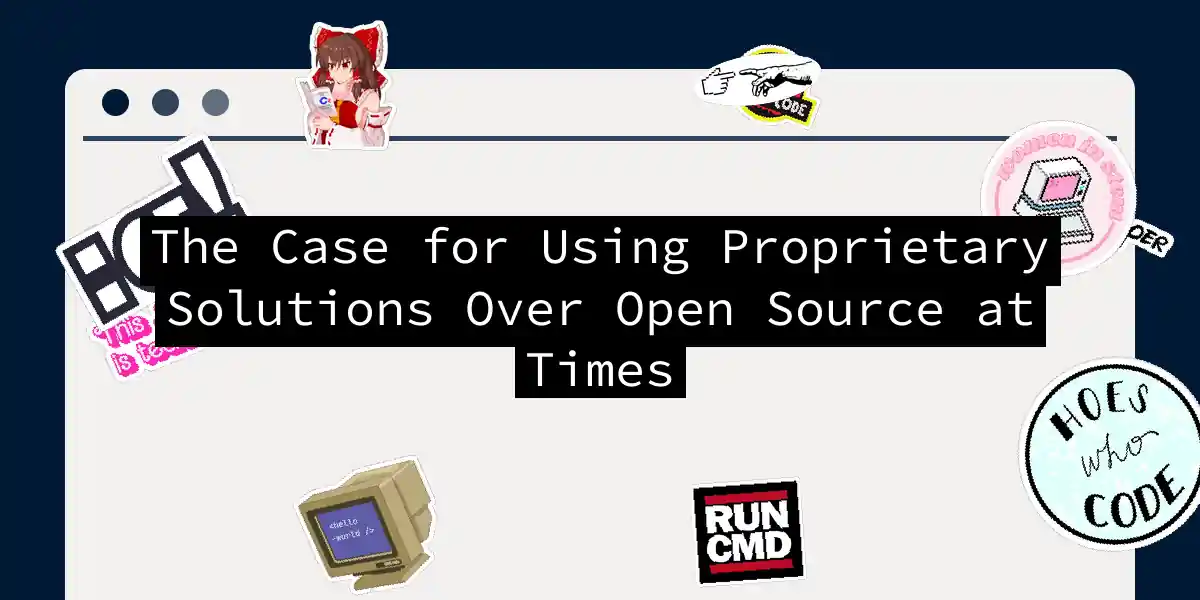When it comes to the age-old debate between proprietary and open-source software, the pendulum often swings heavily in favor of the latter, especially in the developer community. However, there are times when proprietary solutions are not just the better choice, but the only sensible one. In this article, we’ll delve into the scenarios where proprietary software shines, and why you might want to consider it over its open-source counterparts.
Stability and Reliability
One of the most compelling reasons to opt for proprietary software is its stability and reliability. Proprietary solutions are typically developed and maintained by a dedicated team of professionals who are accountable for the software’s performance. This translates into more rigorous testing, better documentation, and a more polished user experience.
For instance, if you’re running a critical business operation, you can’t afford to have your software crashing or behaving erratically. Proprietary software, like Microsoft Office or Adobe Creative Cloud, offers a level of stability that is hard to match with open-source alternatives. Here’s a simple flowchart to illustrate the decision process:
Dedicated Customer Support
Another significant advantage of proprietary software is the dedicated customer support that comes with it. When you encounter an issue with proprietary software, you can rely on the vendor’s support team to help you troubleshoot and resolve the problem quickly. This is particularly important for businesses that cannot afford downtime.
In contrast, open-source software often relies on community support, which, while valuable, can be unpredictable. Here’s an example of how support processes differ:
Ease of Use and User Experience
Proprietary software is often designed with a focus on user experience, making it easier for non-technical users to navigate and use. For example, Apple’s macOS and iOS are renowned for their intuitive interfaces and seamless integration across devices. This ease of use can be a significant factor for businesses looking to onboard new employees quickly or for individuals who are not tech-savvy.
Here’s a comparison of the user experience between proprietary and open-source software:
Intellectual Property Protection
For many businesses, intellectual property protection is a critical concern. Proprietary software offers full intellectual property protections, ensuring that the software and its underlying code are safeguarded against unauthorized use or modification. This is particularly important for companies that rely on software as a key part of their business model.
In contrast, open-source software, while offering some protections through licensing, generally provides less stringent control over how the code is used and modified. Here’s a state diagram illustrating the different states of intellectual property protection:
Cost and Licensing
While open-source software is often free, the cost of proprietary software can be offset by the value it provides in terms of stability, support, and ease of use. Additionally, many proprietary software vendors offer flexible licensing models, including subscription-based services that can be more cost-effective in the long run.
For example, Microsoft’s Office 365 offers a subscription model that includes regular updates, security patches, and access to a suite of productivity tools. Here’s a comparison of the cost models:
Conclusion
While open-source software has its advantages, particularly in terms of customization and community support, there are clear scenarios where proprietary solutions are the better choice. Whether it’s the need for stability and reliability, dedicated customer support, ease of use, intellectual property protection, or a flexible cost model, proprietary software can offer significant benefits that outweigh the costs.
In the end, the decision between proprietary and open-source software should be based on your specific needs and the unique requirements of your project. Here’s a final sequence diagram summarizing the decision process:
So the next time you’re weighing your options, remember that sometimes the best solution isn’t the one that’s free, but the one that’s right for your needs. And if that means opting for proprietary software, then so be it – after all, in the world of software, one size definitely does not fit all.
